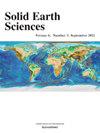Extricating hydrogeochemical evolution of geothermal fluids of an unexplored section in North-Eastern Himalayas, Arunachal geothermal province, India
Abstract
The thermal springs of the study area are situated in North-eastern Arunachal Himalayas, India along Subansiri and Siang River valleys with surface temperature ranging between 20 and 57 °C. The pH of thermal springs varies from 7.69 to 9.31, indicating near neutral to alkaline nature of thermal and non-thermal waters. The major geochemical processes influencing hydrochemistry are demonstrated using conventional graphical plots, geochemical modelling by PHREEQC and multivariate statistical analysis. The thermal waters of Chetu and Taksing in Subansiri valley are primarily Na–Cl and Na–HCO3 type, while, thermal water of Yangte in Siang valley is also mixed water-type and others of Ca–Mg–HCO3 type. The geochemically distinct type of waters is obvious from dendrogram derived from hierarchical cluster analysis. Quartz geothermometer predicts reservoir temperatures of thermal springs of 88 ± 13 °C; while, Na–K Giggenbach geothermometer predicts 182 °C and 176 °C for Chetu and Taksing hot springs. Thermal waters are immature and highly prone to mixing with meteoric waters as evident from enthalpy-chloride modelling. Evaporite dissolution, silicate weathering and ion exchange processes are found to contribute to total ion budget in geothermal waters. The saturation indices studies depict oversaturation of all thermal waters with calcite and dolomite. Considering all geochemical features, a conceptual hydrological model resembling geomorphology and origin of thermal springs of North-Eastern Arunachal Himalaya has been proposed. The thermal waters of Subansiri valley display very high Sr and F− content which prohibit them from drinking and utilization purposes. High concentration of toxic elements is addressed to geogenic causes over anthropogenic contributions due to lesser accessibilities at hot spring spots.

 求助内容:
求助内容: 应助结果提醒方式:
应助结果提醒方式:


